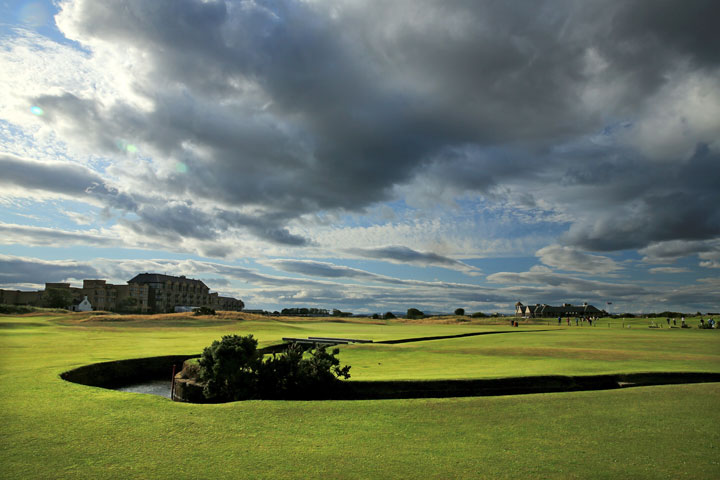ST. ANDREWS, SCOTLAND — There’s nothing more daunting than showing up on the first tee of the Old Course.

It is the home of golf, the place where the game is said to have originated, but that is only one factor that contributes to the nerves of golfers.
The reality is the location, just on the outskirts of St. Andrews’ busy downtown streets, and the resulting meandering tourists, are the real reason golfers get butterflies, even when hitting a tee shot into a fairway that is wider than a football field. No one wants to top a ball or hook one into a roadway or slice another into a nearby stream. In fact, topping a tee shot on one of the most famous courses in the world, in front of dozens of spectators, is simply more than the delicate psyches of most golfers can handle.
READ MORE: Playing the British Open at the Old Course is a dream come true, says DeLaet
Perhaps because the opening tee shot looks so easy, the caddies of St. Andrews feel obliged to start telling tales of the disasters they’ve been witness on the first hole at the Old Course.
The first time I had the chance to play St. Andrews was with my brother and two friends, more than a decade ago. The tee time was 6:30 a.m. and there was a distinct nip in the air, even though it was May. Without warming up (the range is up the road at St. Andrews), our group stepped up to the first tee, took the requisite photos that seem to be snapped by every foursome playing the course, and waited to have our names announced by the starter.
Just before hitting our opening shots, one of our caddies, in his heavy Scottish accent, felt the need to tell us about Ian Baker-Finch, the former British Open winner, had managed the remarkable accomplishment of hitting a ball out of bounds from the first tee and into one of St. Andrews’ fabled streets—a shot that traveled a few hundred yards left—during the 1995 tournament. Then he regaled us with a tale about the Japanese tourist who hit three out of bounds and then three more into the burn that fronts the first green. Oh, and then there was … you get the picture.
Strangely, given the conditions, I was about to become the envy of a large number of my friends. After all, I had done the unthinkable: obtained a slot for four on the Old Course at St. Andrews, the most famous golf course in the world. St. Andrews is also noted for being one of the most difficult places to actually get a tee time. Players often book more than a year in advance or pay thousands for one of the package tours that take them to the fairways of the birthplace of golf.
READ MORE: Tournaments bring focus on Scotland’s great golf courses
In conditions that rival Canada in November, I hooked my first drive down the larger-than-life fairway. Ten minutes later I had recorded my first par at the Old Course. And then we were off on a course that is impossible to fully understand, especially the first dozen or so times you play it.
The Old Course, ostensibly a public golf course owned by the town of St. Andrews, is one of the toughest courses in the world at which to get a round of golf. Players travel all over the world, line up at ungodly early hours and sometimes pay thousands to gain access to its legendary fairways. When my group went to St. Andrews, we left Canada without a tee time, willing to try our hand at the ballot system that distributes half the rounds. If that failed, we were willing to go to extreme lengths to get our round. Television announcer David Feherty told me the way onto St. Andrews was to bribe the starter.
How much should I offer? “It depends on how hung over the starter is,” was the reply.
The thought I might offend someone at the home of golf dissuaded me from that plan.
While demand makes it extremely hard to play the Old Course, it is still a public facility. So available to the public, in fact, that cars drive across the first fairway and townspeople can regularly be seen walking dogs or pushing prams along its fairways. The Old Course, you see, is built on public land, which means it belongs to the town.
READ MORE: Canada’s most exclusive golf courses you may never get to play
With this democratic notion in mind, the Old Course uses a ballot system to give hopeful players the opportunity to hit a ball into the “Sands of Nakajima,” the Road Hole bunker that sits next to the green at the 17th hole.
Luck was with us, as we were selected for the ballot on our first try. All we had to do was enter our names and club affiliations and call in the next day. These days it is all done online with a minimum of fuss.
Unlike most public courses, St. Andrews requires players to have a degree of skill and carry a handicap card from a noted golf organization. Men must play to 24, meaning they will regularly shoot around 96, and women as high as 36, meaning they are not likely to break triple-digit scores. No handicap card, no golf—that’s the rule at St. Andrews.
After having your handicap card scrutinized, players need to fork over their credit card with the green fee being equivalent of around $350.
Once out on the course, golfers experience an otherworldly take on the game. The Old Course is a links, which is best described as an out-and-back golf course played on sandy soil next to the sea. But beyond that, it is unlike any golf course most have ever played.
READ MORE: The best links-like golf courses you can play in Canada
Many dislike the Old Course the first time they play it. Bobby Jones struggled on it during his first rounds. Sam Snead thought it was wildly overrated. But both came to appreciate the quirkiness and delight offered by the course.
What makes St. Andrews so special? Certainly the holes themselves are unique. Lined by gorse—a thorny bush—each hole at St. Andrews offers its own strange take on the game.
Take, for example, the second hole. Unlike most North American holes that clearly dictate the way a golfer should play them, the second at the Old Course has a blind tee shot to a bumpy fairway. Hit it far enough and you’ll be left with an approach to a green with a small hill fronting it. It looks simple enough, but disaster lurks in the gorse and the little nuances of the fairways can dispatch a perfectly good looking drive and deposit it in a hidden bunker.
Given this strangeness, if you’re tackling the Old Course for the first time, you should be prepared to ante up for caddies, which cost around $75, plus tip, which usually amounts to another $20-$25. Without a caddy you’ll likely struggle to find your way around the course with its blind tee shots, massive double greens and unique routing.
The caddies will help you find your way around the particularly treacherous back nine, where the Hell Bunker on the par five 14th, a hole lengthened for the open, snatches balls up, often holding onto them for a couple of strokes.
Playing the final two holes at the Old Course, the famed 17th “Road Hole” and the short 18th, are something every dedicated golfer dreams about. The 17th, a 461-yard par four, starts with an improbable blind tee shot that must fly over a maintenance shed and precariously close to the Old Course Hotel in order to find the fairway. Not surprisingly, shots regularly smash windows at the hotel, leaving maintenance workers scrambling for replacements.
If you’ve managed to survive the famed Road Hole bunker that Tommy Nakajima required five shots to escape from in 1978 and David Duval took four shots to make the green, then you’ll face the crowds that form around the 18th, which plays right up to the edge of town. Locals and tourists sit on benches watching golfers hit shots from “the Valley of Sin” (and try to not embarrass themselves in front on the throng).
I’ve had the chance to tackle the course three times and have hit the green once. It doesn’t look hard, but with people watching it is far more difficult than it immediately appears.
While the pros will tee it up at St. Andrews to battle for the Claret Jug, everyday players pay deadly for the privilege. I’ve coughed up more than a grand to play the Old Course, without taking into account travel and accommodation costs.
And it goes without saying that it was worth every penny—and I can’t wait to do it again.







Comments